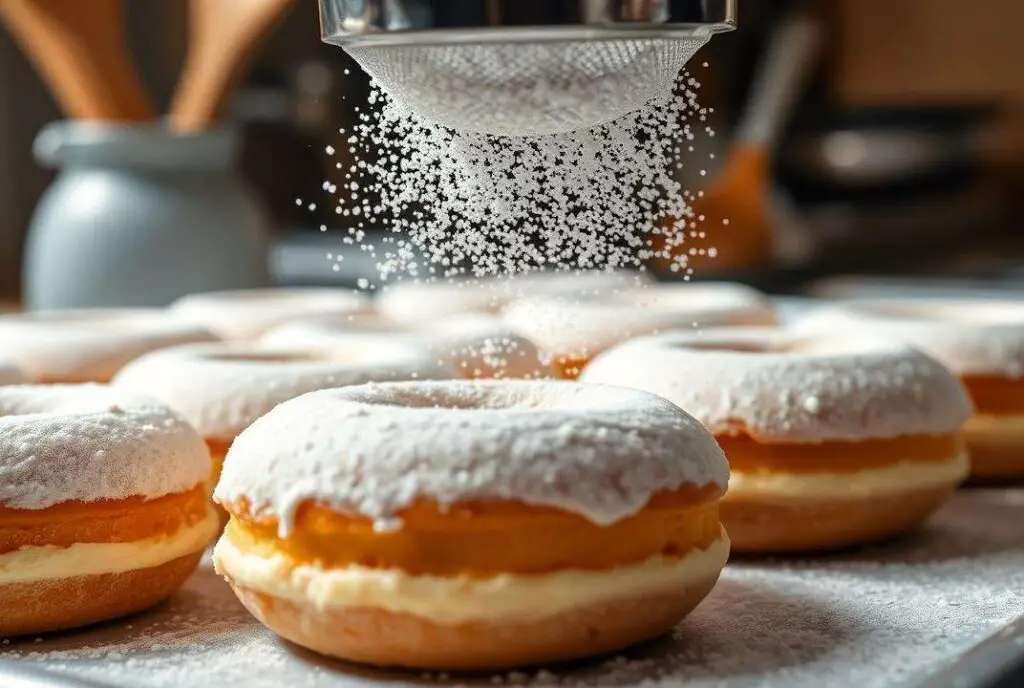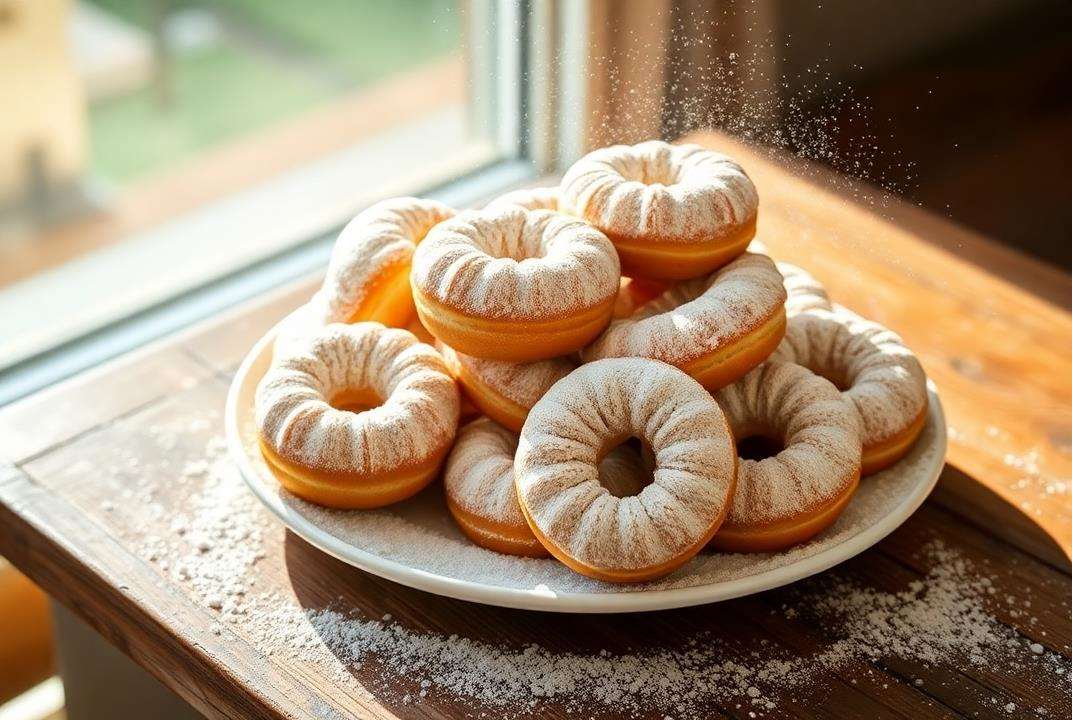Powdered donuts have a way of capturing the hearts—and taste buds—of almost everyone who encounters them. Whether it’s the soft, fluffy texture or that perfect dusting of sweet powdered sugar, these treats are undeniably special. In this guide, we’ll explore every facet of powdered donuts, from their history and global variations to tips for making them at home. You’ll learn what makes them a staple snack and discover fun ways to elevate their flavors. So grab your coffee, settle in, and let’s dive into the wonderful world of powdered donuts!
Introduction to Powdered Donuts
Powdered donuts are more than just a simple snack—they’re a bite-sized piece of comfort, joy, and nostalgia wrapped in a sugary coating. Their journey from a humble treat to a universally loved indulgence is a fascinating one. In this section, we’ll take a closer look at their origin, why they’re so beloved, and how they became a staple in breakfasts and celebrations alike.
The Origin of Powdered Donuts
Where did powdered donuts come from? While there’s no definitive answer, their history is closely tied to the invention of donuts themselves, which date back centuries. Donuts were first introduced in the United States by Dutch settlers, who brought their oliekoek (oil cakes) with them. Over time, the simple fried dough evolved, eventually becoming the iconic ring-shaped treat we know today.
Powdered donuts took this concept one step further by adding a dusting of fine, sweetened powdered sugar, creating the irresistible combination of texture and flavor.
Why Powdered Donuts Are Universally Loved
What’s not to love about powdered donuts? They’re soft, light, and delicately sweet, making them the ultimate comfort food. The velvety powdered sugar coating adds a melt-in-your-mouth sweetness, while the airy texture ensures they’re never too heavy.
Their appeal goes beyond flavor, though. Powdered donuts are portable, easy to share, and perfect for any time of day. Whether paired with a cup of coffee in the morning or served as a late-night snack, they fit into every lifestyle and occasion.
How Powdered Donuts Became a Breakfast and Snack Staple
It’s no surprise that powdered donuts quickly became a beloved breakfast option. With their convenient size and quick energy boost, they’re an easy grab-and-go choice for busy mornings. They’re also a hit at office meetings, birthday parties, and school bake sales, proving their versatility.
Over the years, powdered donuts have cemented their place in food culture. Major brands like Dunkin’ and Hostess popularized them, making them available in grocery stores, bakeries, and coffee shops worldwide. Yet, despite their commercial success, powdered donuts maintain their charm as a homemade treat—a simple pleasure that never goes out of style.
The Ingredients Behind the Magic
Powdered donuts are a testament to the beauty of simplicity, with just a handful of ingredients working together to create this delightful treat. In this section, we’ll break down the essential components of powdered donuts and explore how they can be customized for a modern twist.
Key Components of a Classic Powdered Donut
At the heart of every powdered donut lies a simple dough. The main ingredients—flour, sugar, eggs, and a touch of fat—form the foundation of its pillowy texture. Yeast is often added to create a light, airy structure, while baking powder is sometimes used for denser, cake-style donuts.
The real magic, though, comes in the form of the iconic powdered sugar coating. This fine sugar dusting not only delivers sweetness but also enhances the donut’s soft exterior, making it irresistible with every bite.
The Role of Powdered Sugar: A Sweet Tradition
The powdered sugar, also known as confectioners’ sugar, isn’t just any sugar. It’s finely ground and often mixed with a small amount of cornstarch to prevent clumping. This ensures the sugary coating stays light and fluffy, giving powdered donuts their signature look and taste.
Powdered sugar isn’t limited to the classic white version; you can experiment with flavored varieties by adding a hint of cinnamon or cocoa powder for a unique twist.
Healthier Ingredient Alternatives for a Modern Twist
If you want to indulge in powdered donuts with a healthier spin, you can tweak the recipe without losing their charm. Swap white flour for whole wheat flour to add more fiber or use natural sweeteners like honey or maple syrup instead of refined sugar.
For the powdered sugar, consider making a homemade version with coconut sugar or erythritol, which can provide a lower-calorie alternative. These small changes not only make powdered donuts more nutritious but also bring a depth of flavor that’s perfect for adventurous palates.
Related: Learn how to elevate classic recipes with a modern twist on Sophia’s Meals.
How to Make Powdered Donuts at Home
Making powdered donuts at home might seem intimidating, but it’s a fun and rewarding experience. From preparing the dough to achieving that perfect sugar coating, we’ll guide you through the entire process step by step.

Step-by-Step Dough Preparation
Creating the perfect powdered donut starts with the dough. You’ll need flour, sugar, yeast (or baking powder for cake donuts), eggs, milk, and a bit of butter or oil. Start by mixing the dry ingredients, then slowly add the wet ingredients to form a smooth, elastic dough.
Let the dough rise in a warm place for about an hour, or until it doubles in size. This resting period is essential for achieving that airy, melt-in-your-mouth texture.
Mastering the Frying Process: Techniques and Tips
Frying is where the magic happens, but it’s also the trickiest part of making powdered donuts. Heat the oil to a consistent 350°F (175°C) to ensure the donuts cook evenly. Too hot, and they’ll burn on the outside while staying raw in the middle; too cool, and they’ll absorb excess oil, becoming greasy.
Use a slotted spoon to carefully lower the donuts into the oil, frying them for about 1-2 minutes on each side. Once golden brown, remove them and let them drain on a paper towel to absorb any excess oil.
Applying the Powdered Sugar Coating Like a Pro
Now for the fun part: the powdered sugar coating. Once the donuts have cooled slightly (but are still warm), roll them generously in a bowl of powdered sugar or sift the sugar over them for an even layer. For extra flavor, mix in a pinch of cinnamon or a dash of vanilla powder with the sugar.
To make your powdered donuts look as good as they taste, ensure the sugar covers every inch. This not only enhances their sweetness but also gives them that classic, snowy appearance.
Related: Discover more sweet treats to make at home, like these chocolate croissants.
Variations and Flavor Innovations
Powdered donuts are a blank canvas for creativity. With just a few tweaks to the dough, sugar, or fillings, you can create unique flavor combinations that take this classic treat to the next level. Let’s explore the exciting world of powdered donut variations!
Yeast vs. Cake Powdered Donuts: What’s the Difference?
There are two primary styles of powdered donuts: yeast-based and cake-based. Yeast powdered donuts are light, airy, and have a classic chewiness, while cake powdered donuts are denser and perfect for those who prefer a richer texture.
Yeast donuts are made with an active leavening agent that requires time for the dough to rise. On the other hand, cake donuts use baking powder or soda, which produces instant leavening. Both types create delicious powdered donuts, but the choice depends on personal preference.
If you’re feeling adventurous, why not try making both and comparing their unique textures? You can even mix in natural flavor extracts, like almond or lemon, to enhance each batch.
Adding Natural Flavors to the Dough
The dough of powdered donuts can be transformed into something truly special with a few simple additions. For instance, adding citrus zest such as lemon or orange can create a bright, tangy note. Similarly, warm spices like cinnamon, nutmeg, or cardamom add a cozy flavor profile.
For a more indulgent twist, consider blending cocoa powder into the dough or adding vanilla bean seeds for a richer aroma. These subtle changes create a new spin on a beloved treat while still preserving the charm of powdered donuts.
Unique Powdered Sugar Coating Ideas
The powdered sugar coating doesn’t have to be plain! Infuse the sugar with ground cinnamon or a splash of cocoa powder for added depth. You can also mix in freeze-dried fruit powders, such as strawberry or raspberry, for a fruity twist that adds both flavor and a pop of color.
For a holiday-inspired variation, try adding a pinch of ground peppermint or ginger to the sugar. These playful updates take powdered donuts from simple to stunning in minutes.
Cultural Perspectives on Powdered Donuts
Powdered donuts may be iconic in the United States, but the concept of fried, sugary dough spans cultures worldwide. From European delicacies to Caribbean classics, powdered donuts have inspired countless global variations.
Powdered Donut Inspirations from Around the World
Across the globe, you’ll find treats similar to powdered donuts that showcase the universal love for fried dough. In Germany, Berliners are pillowy fried donuts often filled with jam and dusted with powdered sugar. In Poland, paczki are larger, richer versions, traditionally enjoyed before Lent.
Heading south, the French bring us beignets, square-shaped dough pillows generously coated in powdered sugar. Beignets are famously associated with New Orleans, where they’ve become a cultural staple.
In the Caribbean, a unique twist comes in the form of festival donuts, often paired with savory dishes but sometimes given a sweet coating of sugar. These global variations reveal just how versatile and beloved powdered donuts are.
How Similar Treats Bring Cultural Connections
The beauty of these international donut styles lies in their cultural significance. In many regions, sweet fried dough is tied to holidays, celebrations, or family traditions. Whether it’s a carnival in Europe or a morning coffee break in the United States, powdered donuts and their cousins bring people together.
By incorporating elements from these global variations—like adding a jam filling or experimenting with spices—you can give your powdered donuts a delicious international flair.
If you’re curious about more global-inspired recipes, check out Sophia’s Meals’ article on Asian desserts and traditional treats to savor.
Pairing Powdered Donuts with Beverages
Pairing powdered donuts with the right drink can elevate their flavor and create a satisfying experience. Whether you prefer hot beverages for comfort or cold drinks for a refreshing twist, there are countless options to enhance your enjoyment of these sugary treats. Let’s explore some classic and unique pairings that go perfectly with powdered donuts.

Classic Hot Beverage Pairings
When it comes to powdered donuts, coffee is a timeless companion. A strong black coffee balances the sweetness of the powdered sugar, while a creamy latte or cappuccino enhances the donut’s soft texture.
Tea lovers aren’t left out either. A warm cup of chai, with its spicy notes of cinnamon and cardamom, complements the sugary coating of powdered donuts beautifully. Herbal teas, like chamomile or vanilla rooibos, add a soothing contrast to the rich dough.
For those who prefer indulgence, hot chocolate is another ideal pairing. Its rich, velvety texture mirrors the soft fluffiness of powdered donuts, creating a match made in dessert heaven.
Refreshing Cold Drinks for Sweet Balance
While hot drinks are a go-to option, cold beverages bring a refreshing balance to powdered donuts. A classic glass of milk is hard to beat—it’s creamy, cool, and the perfect palate cleanser between bites.
For a zesty alternative, pair powdered donuts with fresh orange juice. The citrusy tang cuts through the sweetness, leaving you feeling refreshed. Sparkling water or flavored seltzer can also provide a crisp, light counterbalance to the rich donut texture.
Experimenting with flavored smoothies, like berry or banana, adds a nutritious yet tasty twist to your snack time. These options keep things exciting and ensure there’s a drink to suit every taste.
FAQs About Powdered Donuts
When it comes to powdered donuts, a few common questions always pop up. From their ingredients to their nutritional content, let’s tackle the most frequently asked questions about these delightful treats.
What Is the Powder on a Powdered Donut?
The powder on a powdered donut is none other than confectioners’ sugar, also known as powdered sugar. It’s finely ground sugar that’s often mixed with a touch of cornstarch to prevent clumping. This snowy coating is what gives powdered donuts their signature sweetness and melt-in-your-mouth texture.
Does Dunkin’ Donuts Make Powdered Donuts?
Yes, Dunkin’ Donuts offers powdered donuts as part of their classic lineup. Known for their consistent quality and delightful texture, these donuts are a favorite among fans of sweet treats. They’re the perfect grab-and-go option for busy mornings or an afternoon snack.
How Many Calories Are in a Powdered Donut?
The calorie count in powdered donuts varies depending on the size and recipe. On average, a standard powdered donut contains between 200 and 300 calories. While they’re certainly a treat, enjoying them in moderation allows you to savor their flavor without overindulging.
What Are Jamaican Donuts Called?
In Jamaica, a popular sweet treat similar to donuts is called festival bread. Though often served as a savory side dish, festival bread can be dusted with powdered sugar for a sweet variation. Its texture is slightly denser than a traditional powdered donut, but the fried dough’s flavor is just as addictive.
Powdered donuts may have humble beginnings, but their universal appeal continues to spark curiosity and delight around the world.
The Enduring Appeal of Powdered Donuts
Powdered donuts have managed to stand the test of time, capturing the hearts of generations. Their simplicity and nostalgic charm make them an enduring favorite. Let’s explore why these sugar-dusted delights continue to bring joy to people of all ages.
A Treat for All Ages: Nostalgia and Simplicity
One of the reasons powdered donuts remain so popular is their ability to evoke a sense of nostalgia. For many, biting into a powdered donut brings back memories of childhood—whether it was enjoying them at family gatherings, picking up a box on a lazy Sunday morning, or sharing them with friends during school breaks.
The simplicity of powdered donuts is another part of their charm. They require no elaborate decorations or complex ingredients to make an impact. With their soft texture and sweet powdered sugar coating, they offer pure, uncomplicated satisfaction. This straightforward nature appeals to both kids and adults, bridging generational gaps with their timeless appeal.
The Role of Powdered Donuts in Modern Culinary Trends
Even as food trends shift, powdered donuts continue to hold their own. They’ve become a canvas for culinary innovation, inspiring bakers to experiment with flavors, textures, and presentation. From gourmet bakeries adding unique fillings to home cooks experimenting with natural ingredients, powdered donuts are as versatile as they are delicious.
They also tap into the growing appreciation for homemade comfort food. In an age where simplicity and authenticity are highly valued, powdered donuts offer a warm, nostalgic escape that fits perfectly into modern life.
Tips for Making Perfect Powdered Donuts
While powdered donuts are relatively simple to make, a few key tips can ensure your homemade version is as light, fluffy, and delicious as possible. From getting the dough just right to achieving that perfect coating, here’s how to make powdered donuts like a pro.
How to Ensure Dough Rises Properly
The dough is the foundation of any good powdered donut, so it’s important to handle it with care. To help the dough rise properly, use fresh yeast and warm liquids (like milk or water) during mixing. Allow the dough to rest in a warm, draft-free space until it doubles in size—this step is essential for creating soft, airy donuts.
If your dough isn’t rising, it could be due to inactive yeast or a room that’s too cold. A quick fix is to place the dough near a warm oven or cover it with a slightly damp towel to lock in heat and moisture.
Achieving the Perfect Frying Temperature
Frying can make or break powdered donuts, so maintaining the right oil temperature is key. Too hot, and your donuts will burn before they’re cooked through; too cool, and they’ll soak up excess oil and turn greasy.
Aim for an oil temperature of 350°F (175°C) and use a thermometer to monitor it consistently. Fry the donuts for 1-2 minutes on each side until they’re golden brown, and let them drain on a paper towel to remove any extra oil.
Coating Powdered Sugar Evenly and Generously
For that iconic powdered sugar finish, timing is everything. The donuts should be warm—but not too hot—when you coat them to ensure the sugar sticks without melting. Use a large bowl to roll the donuts in sugar or sprinkle the sugar evenly with a sifter for a delicate finish.
For added flair, you can mix the powdered sugar with a pinch of cocoa powder, cinnamon, or even a touch of vanilla powder to customize your donuts. These small details make all the difference in creating the perfect batch of powdered donuts.

